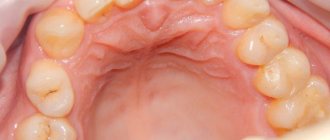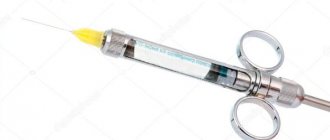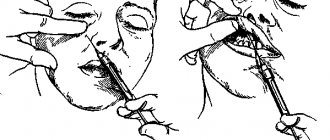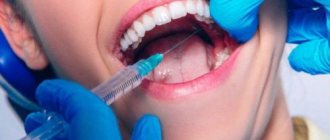Infiltration anesthesia is a type of local anesthesia most common in dental practice. It is this type of pain relief that patients call “freezing.”
Local infiltration anesthesia acts exactly in the area where it was injected. After the injection, all nerve impulses are blocked in this place, the patient does not experience pain or discomfort during dental procedures. At the Left Bank Dental Clinic, infiltration dental anesthesia is used only when necessary and there are no contraindications.
Technique of infiltration anesthesia
The method of infiltration anesthesia was developed at the end of the 19th century, but the anesthetics used at that time were highly toxic.
The technique became more widespread after the introduction of novocaine into practice. This agent could be administered in larger volumes without significant risk of toxicity. The disadvantages of infiltration anesthesia at that time were: delayed development of anesthesia, the need for additional tissue infiltration during surgery, and the risk of toxic effects of the anesthetic. A.V. managed to eliminate these shortcomings. Vishnevsky, who proposed the technique of tight “creeping infiltration”. The method is still widely used in small operations. Features of the technique include the use of a weak solution of novocaine (0.25%) and infiltration of a large volume of anesthetic into fascial closed spaces. The anesthetic solution is injected into the tissue under increased pressure and spreads over a considerable distance within the fascial sheath, while the drug acts on the axons of neurons innervating the intervention area. High hydrostatic pressure promotes closer contact of novocaine with nerve endings. This leads to a rapid development of anesthesia and allows the surgeon to immediately begin the operation. In addition, thanks to the “creeping infiltration” method, hydraulic tissue preparation is ensured, facilitating such surgical procedures as the separation of adhesions, tumor isolation, and others.
The name of Alexander Vasilyevich Vishnevsky is rightfully inscribed in golden letters in the history of domestic surgery and is immortalized in the name of the oldest surgical institute in our country. This name is associated with the emergence and development of a large surgical school, originating from his conceptual method of local anesthesia - “tight creeping infiltrate”, therapeutic novocaine blockades and the doctrine he created about nerve trophism in surgery. And although the name of this once very relevant area of domestic medicine sounds archaic today, many of its provisions still have their way into the science and practice of surgery. Finally, based on this teaching A.V. Vishnevsky developed a harmonious and logical system of wound treatment, many of the provisions of which are still relevant today.
Unfortunately, modern surgeons often encounter this name only on the pages of surgical textbooks and have little idea of its place in domestic surgery.
The path to surgery
A.V. Vishnevsky was born on August 23 (September 4), 1874 in the Chir-Yurt tract in Dagestan, where his father served in the 82nd Infantry Regiment. Having graduated with honors from the Faculty of Medicine of Kazan University in 1899, in November 1903 Alexander defended his doctoral dissertation in physiology[], while simultaneously working as a surgeon in the city Alexander Hospital and as a dissector at the anatomical departments of the university. In 1904-1909 privat-docent A.V. Vishnevsky, continuing to operate, taught at the departments of normal and topographic anatomy, taught a course in operative surgery, and worked in a microbiological laboratory.
Having received such versatile basic knowledge, the young surgeon went to Germany (1904) and France (1908-1909), where he mastered urology and brain surgery, which were poorly developed in Russia in those years. Returning to his homeland in 1910, A.V. Vishnevsky again began surgical activities, this time in a neurological clinic, where he began to perform complex interventions on the brain. Thus, through anatomy, physiology and microbiology, his path to major surgery began.
"Russian" method of anesthesia
A.V. Vishnevsky made contributions to many areas of domestic surgery - the brain, abdominal and thoracic organs, urinary and biliary tracts, in the fight against shock and in the treatment of wounds, but his method of local anesthesia, which is called the Russian method of anesthesia throughout the world, became the most famous. Let us briefly recall its background.
In 1912 A.V. Vishnevsky headed the department of surgical pathology (general surgery) of Kazan University, and during the First World War he simultaneously worked as a surgeon in military hospitals in Kazan. In 1916, he was elected to the department of hospital surgery at the university, where A.V. Vishnevsky began to develop biliary tract surgery.
By the early 20s of the last century, several methods of blocking pain sensitivity were proposed, but all of them were either technically complex or ineffective, especially for diseases of the liver and biliary tract. As A.V. recalled Vishnevsky’s desire to help patients with obstructive jaundice, eliminating the widespread and deadly chloroform anesthesia for them, led him to the idea of creating a universal method that combined conduction and infiltration anesthesia. His method was based on the principle of self-propagation of a heated 0.25% solution of novocaine through the fascial sheaths to the nerve trunks, the excess of which (an important part of the method!) flowed out during the incision. The surgeon, operating alternately with a syringe and scalpel, did not have to wait for the onset of anesthesia, nor search for the nerve with a needle, given the variability of its location.
The first message about his method, which he called “tight creeping infiltrate,” A.V. Vishnevsky did this at the XVII Congress of Russian Surgeons in 1925, when he reported on 22 successful operations on the biliary tract under local anesthesia. In addition to complete anesthesia, the method allowed for hydraulic tissue preparation.
The data on the surgical activity of the hospital surgery clinic of Kazan University for 1928 are indicative: 96 appendectomies, 29 gastric resections, 3 intestinal resections, 16 operations on the biliary tract, 30 hernia repairs, 9 nephrectomies, 12 nephropexies, operations on the brain and spinal cord, lungs and esophagus . At the same time, most interventions by A.V. Vishnevsky performed the procedure under local anesthesia using his own method. And this at a time when almost all major surgeons of the USSR, headed by S.P. Fedorov[] were categorically against “the presence of the patient at the operation.” There was also a categorical ban on injecting local anesthetics into inflamed tissues and around tumors, as well as the danger of poisoning when injecting them (cocaine) in large doses.
To use A.V.’s method, repeatedly tested by him, in wide clinical practice. Vishnevsky proposed in the late 20s - early 30s, publishing in 1929 in the Kazan Medical Journal the article “My method of local anesthesia for operations in the abdominal cavity,” and in 1932 publishing the monograph “Local anesthesia using the method of creeping infiltrate "
In 1929, at the invitation of the dean of the medical faculty of the University of Iowa A.V. Vishnevsky visited the USA, where he gave a presentation on his method, called “Russian”. By the mid-30s, the clinic had experience of almost 10,000 operations under anesthesia with creeping infiltrate, including interventions on the lungs, esophagus, stomach, liver, bile ducts, intestines, kidneys, including such unique operations as today, such as combined nephropexy, cholecystectomy and appendectomy through one incision, two-stage extirpation of the rectum for cancer, resection of the entire colon for ulcerative colitis, resection of the esophagus for cancer from a posterior extrapleural approach, etc.
Many of these operations are performed under local anesthesia A.V. Vishnevsky produced the first in the world. And this at a time when he was criticized for using local anesthesia for a routine (for him) cholecystectomy!
It should be noted that venerable surgeons criticized, and their rural colleagues, who knew more than others the imperfections of mask anesthesia and were sometimes forced to limit their operational activity to outpatient surgery all their lives, were on his side. "Method of Prof. A.V. Vishnevsky allows you to calmly carry out any major operation... which creates the opportunity for surgeons to quickly master the technique of practical surgery and provide qualified assistance in the periphery,” wrote rural surgeon M.Kh. in 1934. Shalunov. “There is essentially no area where it would be impossible, using A.V.’s method. Vishnevsky, operating painlessly... The method brought major surgery out of the walls of clinics and large hospitals into small hospitals in the periphery,” echoed a colleague in 1937, former zemstvo surgeon Professor BC Levit.
Today we can evaluate in different ways the contribution made to Russian surgery by A.V. Vishnevsky and his followers developed and implemented a “creeping infiltration”. Thus, there is an opinion that the method has slowed down the development of endotracheal anesthesia and, as a consequence, thoracic surgery in our country, but this is not so. The first pneumonectomy for lung cancer A.V. Vishnevsky produced it back in 1937, i.e. 10 years earlier than this operation was performed by the country's leading surgeons (V.N. Shamov, A.N. Bakulev, P.A. Kupriyanov, L.K. Bogush, etc.). Why did he succeed? Yes, because, in addition to the anesthesia technique, which he brilliantly mastered, during lung operations A.V. Vishnevsky used the vagosympathetic blockade he developed, which other surgeons did not know.
“The successes of thoracic surgery in the USSR are largely due to the widespread use of local anesthesia,” wrote A.A. in 1949. Vishnevsky (senior). Son A.V. has his own opinion Vishnevsky was justified by his own experience, operating in the 50s under local anesthesia on the lungs and heart (using closed techniques). To critical remarks about the too broad indications for “creeping infiltration,” father and son responded that local anesthesia is indicated where there are contraindications to anesthesia, and its effectiveness depends not on the method as such, but on the surgeon’s ability to use it. After all, most likely, opponents of the method either used it not according to indications, or did not fully master its technique. But the term “krikain”, which they used in print and has survived to this day, did not add to the popularity of the method.
History has put everything in its place. The years of the Great Patriotic War contributed to the recognition of the method used in the clinic in the early 30s. “Based on the creation of A.V. Vishnevsky’s method of pain relief also changed the surgical technique itself, it became more beautiful, gentle, and anatomical,” recalled who worked in Kazan at the beginning of the war under the supervision of A.V. Vishnevsky V.V. Kovanov.
Let us also quote the words of one of the founders and pioneers of Russian anesthesiology, Professor T.M. Darbinyan: “Local anesthesia according to A.V. Vishnevsky played an extremely important role in the development of Soviet surgery. The reason for this lies in the fact that the principle underlying it, paradoxically, is identical to the principle of modern endotracheal anesthesia and consists of a combination of analgesia and the preservation of reflex self-regulation of vital functions. And today, paying tribute to anesthesia, we should not forget that there is no safer method of anesthesia than local anesthesia.”
It is difficult to add anything to these words.
The doctrine of nervous trophism in surgery and the wound treatment system developed by A.V. Vishnevsky
Application of A.V. Vishnevsky novocaine for therapeutic purposes began with the treatment of limb ulcers with spontaneous gangrene at the department of faculty surgery with the clinic of Kazan University, the head of which he was elected in 1926. Based on the neurogenic theory of dystrophies A.D. Speransky[], with whom he began to collaborate in the early 30s, A.V. Vishnevsky proposed a method of turning off the trophic innervation of tissues by blocking the reflex arc of the pathological focus, as a result of which lumbar, presacral, sheath, vagosympathetic blockades and a short novocaine block were introduced into the clinic.
Soon the idea of a complete interruption of nerve impulses during blockade, which was supported by most surgeons, was replaced by the original concept of A.V. Vishnevsky about the nervous regulation of trophic processes under these conditions, and to continue its scientific and clinical development in 1935, he was invited to Moscow, where, on the basis of the Moscow Regional Clinical Institute, he headed the surgical clinic of the All-Union Institute of Experimental Medicine (VIEM) named after. AM Gorky and the Department of Surgery of the Central Research University of Doctors.
In 1937, for an additional effect on the reparative regeneration of damaged tissues, A.V. Vishnevsky suggested another weak irritant - Peruvian balsam emulsified in oil. “If the method of local anesthesia according to A.V. Vishnevsky brought major surgery out of the walls of large clinics into small hospitals in the periphery, then his theory about weak irritation of the nervous system as a healing factor finally brought the doctrine of nervous trophism out of the walls of physiological laboratories into the wide world of practical medicine. This is one of the greatest examples of the unity of theory and practice,” wrote one of A.V.’s students. Vishnevsky professor A.N. Redhead.
The method of treating wounds with an oil-balsamic emulsion, called “Vishnevsky ointment,” was based on the principle of the identity of the biological essence of inflammation and wound healing. Applied after a thorough surgical treatment of the wound, performed under novocaine blockade or local anesthesia, and always for a long time, the emulsion-impregnated bandage had (according to the author) a weak neurotrophic (irritating and stimulating) effect on the wound. After cleansing, the wound was sutured, introducing the same emulsion between the sutures and eliminating the pain reaction with a regional novocaine blockade.
The “ointment” containing tar[], xeroform and castor oil had practically no contraindications and for many years was widely used to treat inflammatory diseases of various etiologies, localization and distribution, including specific ones, such as tuberculosis, especially during the Great Patriotic War.
In 1941-1944. based on the leadership of A.V. Vishnevsky of the VIEM surgical clinic worked at military hospital No. 5002, and the head of the clinic was awarded several awards: the People's Commissariat of Health Prize (for the development and implementation of a “creeping infiltrate”), the Stalin Prize (for the development and implementation of novocaine blockades and oil-balsamic dressing), the Order of the Red Labor Banner and Order of Lenin.
“Our school, having been developing issues of inflammation for many years, came up with ready-made proposals in the field of military field surgery. Many of them received full approval by the GVSU of the Red Army [],” wrote A.V. in 1944. Vishnevsky. It is estimated that every third person wounded during the war received treatment according to A.V. Vishnevsky - local anesthesia (for operations and wound treatment), novocaine block (as an anti-shock and therapeutic agent) or a balsamic dressing (for the treatment of wounds and fractures).
During these years, continuing to study the problem of wound healing, A.V. Vishnevsky was the first to introduce into purulent surgery the concept of active wound treatment, meaning by this the active intervention of the surgeon in the course of the wound process at any stage of its development, directing it in the direction necessary for wound healing. The concept of active treatment also included the primary suture of a traumatic wound and the so-called tampon-free treatment of a sutured wound, when a heated oil-balsamic emulsion was injected with a syringe between its edges (more precisely, between the sutures).
The concept of A.V. is interesting and modern. Vishnevsky about secondary treatment of purulent wounds and reconstructive operations in conditions of purulent infection, i.e. something that from the point of view of surgery of the middle of the last century seemed unacceptable and which is the norm of modern purulent surgery. The author was able to carry out these operations using his “system”, which many other surgeons did not possess.
Based on the dystrophic theory of inflammation, A.V. Vishnevsky came to the idea of the unity of local and general in the pathogenesis of sepsis and put forward a modern-sounding thesis about starting the treatment of sepsis with mandatory surgical sanitation of the primary focus. The same applies to his understanding of the pathogenesis of traumatic and surgical shock. Considering shock as “a complex degenerative process caused by overstimulation of the nervous system,” A.V. Vishnevsky predicted the effectiveness of vagosympathetic blockade not only as an antishock agent, but also as a basic condition in lung and heart surgery.
In 1946, assessing the contribution of A.V. Vishnevsky and his school in military field surgery, head of the GVSU of the Soviet Army E.I. Smirnov wrote: “The huge difference in the results of treatment of penetrating chest wounds during the Patriotic War compared to past wars is explained by the universal recognition and widest use of the vagosympathetic blockade according to Vishnevsky. Along with this, the school A.V. Vishnevsky had a great influence on the treatment of other traumatic injuries and their complications - bones, joints, abdomen...”
Recognition of the merits of A.V. Vishnevsky's achievements in domestic surgery were his election as an academician of the USSR Academy of Medical Sciences (1946), chairman of the Surgical Society of Moscow and the Moscow Region (1946), as well as the creation of a clinic on the basis of his clinic in the building of the former almshouse of P.M. Tretyakov at the Shchipka Institute of Surgery of the USSR Academy of Medical Sciences (1947) and his appointment as director of this institute (1947), which he led until his death.
School A.V. Vishnevsky
Among the students of A.V. Vishnevsky Kazan period of his life and work (1910-1935) S.M. became doctors of medicine and professors. Alekseev, S.I. Voronchikhin, I.V. Domrachev, S.M. Kurbangaleev, I.S. Malinovsky, N.V. Sokolov, S.A. Flerov and I.F. Kharitonov.
Working in Moscow (1935-1948), A.V. Vishnevsky trained professors A.G. Gilman, P.N. Maslova, E.K. Young, G.M. Novikova, B.K. Osipova, S.P. Protopopova, V.I. Pshenichnikova, G.A. Richter, N.F. Rupasova, A.N. Ryzhikh, A.A. Troitsky, V.V. Turbin, as well as his son A.A. Vishnevsky (senior), who became an academician.
Many of these scientists created their own schools, some stood at the origins of new directions in domestic surgery (A.A. Vishnevsky and B.K. Osipov - surgery of heart defects, A.N. Ryzhikh - coloproctology), and six of them (S M. Alekseev, A. A. Vishnevsky, I. V. Domrachev, S. P. Protopopov, A. N. Ryzhikh and N. V. Sokolov) were awarded the title of Honored Scientist of the RSFSR. It is noteworthy that all scientific and pedagogical teams, which at one time were led by A.V. Vishnevsky, was headed by his students: the Department of General Surgery in Kazan - Professor I.F. Kharitonov, faculty - S.M. Alekseev, hospital - N.V. Sokolov, Department of Surgery, CIU doctors - B.K. Osipov, and the son took over from his father’s hands the Institute of Surgery of the USSR Academy of Medical Sciences.
The logical sequence of ideas that led to the creation of his school was described by A.V. himself. Vishnevsky summed it up this way: “During our scientific and practical work, we developed two big problems: local anesthesia and wound treatment. Work on the 1st problem led us to the discovery of the principle of sheath-creeping anesthesia <…>. In turn, this led to the development of various types of novocaine blockade. Work on the 2nd problem led to the discovery of a special system for treating purulently infected wounds with oil antiseptics. The system of wound treatment led to the posing of the question of active wound drainage, which in turn raised the questions of secondary wound treatment, drainage of a closed purulent cavity, layered tamponade, etc. This led to the questions of osteosynthesis in an infected wound, the problem of an amputation stump, economical resection of joints, etc. "The generalization of this material has led us to a special understanding of the emergence and development of a number of diseases as neuro-dystrophic processes"[].
There is an opinion according to which the school of A.V. Vishnevsky should include all surgeons who have ever used local anesthesia, novocaine blockades or wound treatment according to Vishnevsky in practice.
One can argue with this, but let us remember the similar point of view of V.A. Oppel, who wrote about N.I. Pirogov: “His school is all Russian surgery.”
The Vishnevsky dynasty and his memory
Glorious deeds of A.V. Vishnevsky was continued by his son, one of the creators of domestic heart and vascular surgery, Hero of Socialist Labor, Lenin Prize laureate, Academician of the USSR Academy of Medical Sciences Alexander Aleksandrovich Vishnevsky (senior), who headed the Institute of Surgery of the USSR Academy of Medical Sciences from 1948 to 1975. Recently, the third representative of the glorious dynasty, a major thoracic and plastic surgeon, laureate of the USSR State Prize, Professor Alexander Aleksandrovich Vishnevsky (junior), who for a long time headed the thoracic department at this institute, passed away.
The family tradition is continued by his daughter, great-granddaughter A.V. Vishnevsky, thoracic surgeon and doctor of medical sciences Galina Aleksandrovna Vishnevskaya, working at the Russian Scientific Center for Surgery named after. B.V. Petrovsky.
If we remember that the medical career of A.V. Vishnevsky began in 1899, it turns out that the Vishnevsky surgical family has been benefiting their homeland for more than 100 years. Amazing consistency!
Today in the name of A.V. Vishnevsky named the Institute of Surgery of the Ministry of Health of the Russian Federation in Moscow and the multidisciplinary Krutinskaya Central District Hospital in the Omsk region, streets in Kazan (Republic of Tatarstan), Kizil-Yurt, Khasav-Yurt and several villages of Dagestan. Monuments in his honor were erected in Moscow, on the territory of the Institute of Surgery, and in Kazan, at the intersection of L. Tolstoy and A. Butlerov streets.
There is no doubt that the name and deeds of A.V. Vishnevsky is destined to live a long life. His methods have long become classic and are unlikely to ever disappear from the surgical arsenal, and the concept of active and complex treatment of wounds, based on the possibility of a surgeon’s intervention in the wound process at any stage of its development, is fully implemented by the followers of the outstanding surgeon, working as in the institute named after him, and in many surgical clinics in Russia.
[] Vishnevsky A.V. On the issue of peripheral innervation of the rectum: Abstract. dis. ...Dr. med. Sci. Kazan 1904.
[] In 1933, the first Soviet surgeon S.P. Fedorov (1869-1936) was awarded the Order of Lenin, which may indirectly indicate his leadership in domestic surgery.
[] Speransky Alexey Dmitrievich (1888-1961), student of I.P. Pavlova, academician of the USSR Academy of Sciences and Academy of Medical Sciences, creator of the doctrine of nervous trophism in medicine.
[] Initially, the ointment included Peruvian (Peruvian) balm from the bark of the cinchona tree, which was later replaced by cheaper and more accessible tar.
[] Main Military Sanitary Directorate of the Workers' and Peasants' Red Army.
[] The final chapter from the book by A.V. Vishnevsky "Local anesthesia... infiltration." Ed. 4th. Surgery 1949; 5:5-8.
Anesthesia technique
A solution of novocaine is injected intradermally with a thin needle, warmed to body temperature. As a result, a “lemon peel” is formed at the site of the upcoming cut. Then a thicker needle is used to infiltrate the subcutaneous tissue and create a subcutaneous novocaine infiltrate. After this, the skin and subcutaneous tissue are dissected to the aponeurosis. Following this, the subgaleal space is tightly filled with novocaine solution, ending with the opening of the aponeurosis. If the intervention requires it, subsequent anesthesia of the peritoneum, mesentery or pleura, and the root of the lung is performed. In all cases, when performing infiltration anesthesia, the surgeon adheres to the rule - infiltration with an anesthetic must precede an incision with a scalpel. Novocaine blockades proposed by A.V. are based on a similar principle. Vishnevsky. It also uses tight filling of anatomical “cases” with anesthetic, which does not require direct application of the drug to the nerve trunks.
Types of infiltration anesthesia
Conventionally, two types of infiltration anesthesia can be distinguished: direct and indirect. With direct anesthesia, the drug is injected directly into the surgical area. This type of anesthesia is used during soft tissue operations.
With the indirect (diffuse) type of infiltration anesthesia, the anesthetic is administered at some distance from the area that needs to be anesthetized. By diffusion, the solution reaches the tissues in the intervention area. For example, introducing an anesthetic solution around the surgical field when opening an abscess or injection under the periosteum when numbing a tooth. The effect of the drug is determined not only by the pharmacokinetic properties, concentration and amount of solution, but also by the condition of the infiltrated tissues (local inflammation, scar-adhesive process reduce the analgesic effect).
Conduction anesthesia
With conduction anesthesia, the anesthetic is injected into the area of the nerve trunk that innervates the surgical area. For example, during operations on the fingers, the anesthetic is injected at the base of the finger, and during operations on the upper limb - into the brachial plexus area. For conduction anesthesia, higher concentrations of anesthetics are used (1-2% solutions of lidocaine and novocaine), but in smaller volumes than for infiltration anesthesia. After administration of the anesthetic, complete anesthesia requires time (5-10 minutes), during which the anesthetic penetrates the entire thickness of the nerve.
Options for using infiltration anesthesia
The technique of local anesthesia has its own characteristics depending on the type of operation and area of intervention. Currently, the classic version of infiltration anesthesia according to A.V. Vishnevsky is rarely used, but its elements continue to be used during various operations, including abdominal interventions.
One type of infiltration anesthesia is case blockade . It may be required for injuries or operations on the extremities. It is performed using a 0.25% solution of novocaine, trimecaine or lidocaine by introducing flexors or extensors into the sheaths. To do this, the skin and muscles are anesthetized, and then using a thin needle they reach the bone and, retreating a few millimeters, inject a certain amount of anesthetic. The drug is usually administered from two points. For closed fractures of the tubular bones of the extremities, the anesthetic can be injected directly into the hematoma.
Several types of infiltration anesthesia are used in dentistry: intramucosal, submucosal, spongy anesthesia, intrapulpal, intraligamentary, infiltration anesthesia of soft tissues, anesthesia under the periosteum.
Local infiltration anesthesia according to Vishnevsky.
Local infiltration anesthesia according to Vishnevsky.
Indications: Used as a method of pain relief during surgical treatment of wounds; at the initial stages of conduction anesthesia and blockade of cellular spaces; during puncture of serous cavities and pathological space-occupying formations; when opening post-injection abscesses, boils and suppurating atheromas; when removing benign tumors of the skin and subcutaneous fat (papillomas, lipomas, fibromas), removing various types of granulomas. This method can also be used as a method of “hydraulic preparation” of tissue (for example, when isolating a hernial sac).
Contraindications: diffuse purulent inflammation, neuropsychiatric diseases and disorders.
Pathogenetic rationale: The method of infiltration anesthesia according to Vishnevsky is based on the teaching of N. I. Pirogov about the case structure of the human body. In his works, A. V. Vishnevsky writes “During the operation, strictly layer-by-layer and anatomical administration of weak solutions of novocaine in the form of a creeping infiltrate under the skin, fascial sheaths, aponeuroses, preperitoneal tissue, as well as duplication of the peritoneum, the goal is to block the nerve endings by direct contact with them of the anesthetic solution, which accelerates the onset of the analgesic effect.”
Technique: Layer-by-layer infiltration anesthesia involves alternating a scalpel and a syringe with an anesthetic solution during the operation. First, along the line of the intended incision, the skin is anesthetized by forming an intradermal novocaine nodule (creating a “lemon peel” - Fig. 1), then a tight novocaine infiltrate is created in the subcutaneous fat fiber. In this case, it is necessary to observe the principle “the end of the needle follows the stream of novocaine.”
Rice. 1. Lemon peel type skin anesthesia.
The intradermal position of the needle allows you to change its direction within 360˚ and inject the anesthetic in a fan-shaped manner. If you need to refill the syringe with novocaine, you should not remove the needle, just remove the syringe from the needle. When pain relief is performed correctly, the patient only feels the first injection. After anesthesia of the subcutaneous fat tissue, if necessary, anesthesia of the deeper-lying fascial sheaths is also performed by means of a tight creeping infiltrate and, as a rule, after dissection of the skin and subcutaneous tissue.
Tool kit and medications necessary to perform the practical skill: antiseptic for skin treatment; 0.25% novocaine solution; syringe; sterile gloves.
Anesthesia (blockade) of the site of a tubular bone fracture.
Indications: closed fractures of long bones.
The method refers to local infiltration anesthesia, while peripheral pain analyzers are blocked.
Technique: The skin over the site of a closed fracture is anesthetized in a “lemon peel” manner. The needle insertion site should be away from the projection of the great vessels and nerve trunks and only through intact skin. The hematoma is punctured with a needle, as evidenced by the flow of blood into the syringe during the reverse stroke of the piston, and 10-50 ml of a 1-2% anesthetic solution is injected. Do not insert a needle into a place where bone fragments are located directly under the skin. In case of multiple fractures, each segment is anesthetized separately, taking into account the total amount of anesthetic, reducing its concentration accordingly.
Tool kit and medications necessary to perform the practical skill: antiseptic for skin treatment; syringe; sterile gloves; ampoules with 1-2% anesthetic solution for infiltration anesthesia (novocaine, lidocaine, prilocaine, trimecaine, chloroprocaine).
Spinal anesthesia.
Indications: Spinal anesthesia is used for surgical interventions on the lower half of the body: the lower floor of the peritoneal cavity, perineum, lower extremities (for example, for hernia repair, hip replacement, appendectomy, uterine amputation, venectomy of the lower extremities, etc.).
Contraindications: There are absolute and relative contraindications to spinal anesthesia:
Absolute contraindications: increased intracranial and spinal pressure; diseases of the central nervous system; skin infection at the puncture site; severe hypovolemia; severe arterial hypotension (below 90 mm Hg); sepsis.
Relative contraindications: previous spinal surgeries; spinal column deformities; back pain, psycho-emotional lability of the patient; hypertensive crisis .
Pathogenetic rationale: In this case, it is necessary to recall some anatomical issues. The spinal cord is located in the spinal canal, formed by the posterior surface of the vertebral bodies and their arches and surrounded by membranes. Between the arachnoid membrane, directly adjacent to the spinal cord, and the dura mater, a space is formed filled with cerebrospinal fluid (CSF). The dura mater is impermeable to fluid and performs a protective function for the spinal cord. In the cranial direction, the dura mater of the spinal cord passes into the dura mater of the brain, forming a common closed space for the brain and spinal cord.
Spinal anesthesia is based on the injection of an anesthetic into the subarochnoid (subdural) space after a lumbar puncture. The selected anesthetic (novocaine, lidocaine, trimicaine) is mixed with cerebrospinal fluid (CSF) and affects the spinal cord: blocking its posterior roots leads to loss of pain, tactile, temperature sensitivity, and the anterior ¾ of motor paralysis (myorelaxation). The level of blockade depends on the location of the spinal puncture, the spread of the anesthetic through the subarochnoid space, depending on the position of the patient, the amount of anesthetic, and cerebrospinal fluid pressure.
Spinal anesthesia was first described by Beer in 1899. Over a century, this method of regional anesthesia has experienced both periods of complete oblivion and surges in popularity, which is associated with the emergence of new low-toxic local anesthetics and improvements in the technique of spinal puncture.
Technique: The spinal anesthesia procedure begins with premedication. The basis for this is an explanation, accessible to the patient, of the nature of the procedure itself and possible complications. Sedatives (Seduxen, Relanium) can be used as medicinal premedication, and atropine can be used for abdominal operations. After obtaining the patient’s consent to this type of anesthesia, its implementation begins.
The patient takes a forced position on the operating table (sitting or lying on his side) with his knees brought to the stomach and his head lowered (“fetal position”), which creates a convexity of the spinal column with an increase in the distance between the spinous processes. The puncture site is determined (Fig. 2). The optimal intervertebral gap is between L IV – LV, which corresponds to the horizontal line between the posterior iliac spines.
Rice. 2. Position of the patient on the operating table and
determination of the level of spinal puncture.
The surgical field is treated with an antiseptic and protected with sterile sheets. It must be remembered that when treating the surgical field with iodine preparations, they must be removed before puncture. The entry of iodide preparations into the subarochnoid space is unacceptable. At the level of the selected intervertebral, strictly along the midline between the spinous processes, the skin and underlying layers are anesthetized with an anesthetic (Novocaine, Lidocaine). After local infiltration anesthesia has been performed, they proceed directly to puncture of the subarochnoid space. This is done with a special needle with a mandrel (Fig. 3), which is inserted strictly in the sagittal plane between the spinous processes of the lumbar vertebrae at an angle of no more than 5-10˚ in accordance with the inclination of the spinous processes.
Rice. 3. Needles with mandrel for spinal anesthesia
As the needle advances, resistance is felt due to passing through the interspinous and yellow ligament, after which the needle falls into the suborochnoid space, as evidenced by the release of clear fluid (CSF) from the needle pavelion after removal of the mandrel (Fig. 4).
Rice. 4. The appearance of cerebrospinal fluid in the needle pavelion.
After removing 5 ml of cerebrospinal fluid, an adequate amount of the selected anesthetic is injected. Anesthesia occurs in 10-15 minutes, lasting up to 2-2.5 hours.
Complications of spinal anesthesia are associated with the technique of performing the procedure:
1. Damage to the spinal cord due to a needle during high punctures.
2. Infection of the cerebrospinal fluid resulting in myelitis and meningitis.
3. The effect of the anesthetic on the high segments of the spinal or longitudinal cord (drop in blood pressure, respiratory arrest).
All complications of spinal anesthesia can be avoided with strict adherence to the rules of asepsis and antisepsis, correct choice of the site of spinal puncture and strict dosage of the anesthetic substance.
Instrumental set and medications necessary to perform the practical skill: Spinal anesthesia is carried out in an operating room with strict adherence to the rules of asepsis and antisepsis. For spinal puncture, a special needle is required, the peculiarity of which is a bluntly beveled end and the presence of a mandrel; the needle is 10-12 cm long, with a diameter of no more than 5 mm. 4 ml of 5% novocaine solution is used as an anesthetic; 5 ml of 2% trimecaine solution, 5 ml of 2% lidocaine solution, 5 ml of 1% ropivacaine solution, 5 ml of 0.5% marcaine. It is necessary to have means to relieve possible complications: vasoconstrictor drugs, respiratory analeptics (lobeline, cardamine, cititon, caffeine), atropine, ventilator. To prevent hypotension, ephedrine is administered intramuscularly 15 minutes before spinal anesthesia.
Paravertebral blockade.
Indications: intercostal neuralgia of various etiologies, degenerative-dystrophic diseases of the lumbar spine with radicular syndrome.
With the patient lying or sitting, the line of the spinous processes is determined. Stepping 3-3.5 cm below and 1-1.5 cm caudal to the corresponding spinous process, a needle is inserted and passed vertically in relation to the skin, infiltrating with anesthetic. At a depth of 4 cm, the needle rests on the transverse process. Having slightly changed the direction, the needle is passed along the upper or lower edge of the transverse process to a depth of 1 cm and 10-15 ml of 0.5 - 1% novocaine solution is injected. Thus, the branches of the posterior branch of the spinal nerve, which innervate the facet joints, muscles and ligaments of the dorsal surface of the body, are blocked.
Intercostal novocaine blockade.
Indications: single and multiple rib fractures, chest bruises, intercostal neuralgia.
Technique: Position the patient on the healthy side or sitting. At the most painful point or 3-4 cm away from the site of crepitation of bone fragments towards the spine, insert the needle all the way into the lower edge of the rib, infiltrating the soft tissue with a 1% novocaine solution. Then, tilting the needle tip caudally and sliding off the lower edge of the rib, an aspiration test is performed and another 5-10 ml of anesthetic is injected. To enhance the effect of the anesthetic, medical alcohol can be added to it in a ratio of 4:1.
Local infiltration anesthesia according to Vishnevsky.
Indications: Used as a method of pain relief during surgical treatment of wounds; at the initial stages of conduction anesthesia and blockade of cellular spaces; during puncture of serous cavities and pathological space-occupying formations; when opening post-injection abscesses, boils and suppurating atheromas; when removing benign tumors of the skin and subcutaneous fat (papillomas, lipomas, fibromas), removing various types of granulomas. This method can also be used as a method of “hydraulic preparation” of tissue (for example, when isolating a hernial sac).
Contraindications: diffuse purulent inflammation, neuropsychiatric diseases and disorders.
Pathogenetic rationale: The method of infiltration anesthesia according to Vishnevsky is based on the teaching of N. I. Pirogov about the case structure of the human body. In his works, A. V. Vishnevsky writes “During the operation, strictly layer-by-layer and anatomical administration of weak solutions of novocaine in the form of a creeping infiltrate under the skin, fascial sheaths, aponeuroses, preperitoneal tissue, as well as duplication of the peritoneum, the goal is to block the nerve endings by direct contact with them of the anesthetic solution, which accelerates the onset of the analgesic effect.”
Technique: Layer-by-layer infiltration anesthesia involves alternating a scalpel and a syringe with an anesthetic solution during the operation. First, along the line of the intended incision, the skin is anesthetized by forming an intradermal novocaine nodule (creating a “lemon peel” - Fig. 1), then a tight novocaine infiltrate is created in the subcutaneous fat fiber. In this case, it is necessary to observe the principle “the end of the needle follows the stream of novocaine.”
Rice. 1. Lemon peel type skin anesthesia.
The intradermal position of the needle allows you to change its direction within 360˚ and inject the anesthetic in a fan-shaped manner. If you need to refill the syringe with novocaine, you should not remove the needle, just remove the syringe from the needle. When pain relief is performed correctly, the patient only feels the first injection. After anesthesia of the subcutaneous fat tissue, if necessary, anesthesia of the deeper-lying fascial sheaths is also performed by means of a tight creeping infiltrate and, as a rule, after dissection of the skin and subcutaneous tissue.
Tool kit and medications necessary to perform the practical skill: antiseptic for skin treatment; 0.25% novocaine solution; syringe; sterile gloves.
Anesthesia (blockade) of the site of a tubular bone fracture.
Indications: closed fractures of long bones.
The method refers to local infiltration anesthesia, while peripheral pain analyzers are blocked.
Technique: The skin over the site of a closed fracture is anesthetized in a “lemon peel” manner. The needle insertion site should be away from the projection of the great vessels and nerve trunks and only through intact skin. The hematoma is punctured with a needle, as evidenced by the flow of blood into the syringe during the reverse stroke of the piston, and 10-50 ml of a 1-2% anesthetic solution is injected. Do not insert a needle into a place where bone fragments are located directly under the skin. In case of multiple fractures, each segment is anesthetized separately, taking into account the total amount of anesthetic, reducing its concentration accordingly.
Tool kit and medications necessary to perform the practical skill: antiseptic for skin treatment; syringe; sterile gloves; ampoules with 1-2% anesthetic solution for infiltration anesthesia (novocaine, lidocaine, prilocaine, trimecaine, chloroprocaine).
The essence of Vishnevsky's method is as follows:
1. The novocaine solution (fresh, of course) is heated to body temperature; 2. Fill it into a syringe (2 ml); 3. Liquid is injected under the skin.
As a result, a so-called lemon peel should form.
Gradually they move further and infiltrate other areas.
Vishnevsky included the following substances in his solution:
- sodium chloride (5 g);
- potassium chloride (0.075 g);
- calcium chloride (0.125 g);
- distilled water (1000 ml);
- and, in fact, novocaine (2.5 g).
For example, 50 ml of anesthetic is quite enough to anesthetize the upper jaw.
Advantages and disadvantages of infiltration anesthesia
The positive properties of infiltration anesthesia include:
- ease of implementation, accessibility of manipulation;
- maintaining the possibility of contact with the patient;
- the safety of infiltration anesthesia is ensured by the distance from the injection site of large vessels and nerve trunks and the use of a smaller amount of anesthetic with a faster effect compared to conduction anesthesia.
However, infiltration anesthesia has a number of disadvantages and limitations, in particular:
- possibility of allergic reactions;
- psycho-emotional stress of the patient, especially during prolonged manipulations;
- cannot be used during extensive interventions that require muscle relaxation, mechanical ventilation and other methods to minimize surgical trauma.










